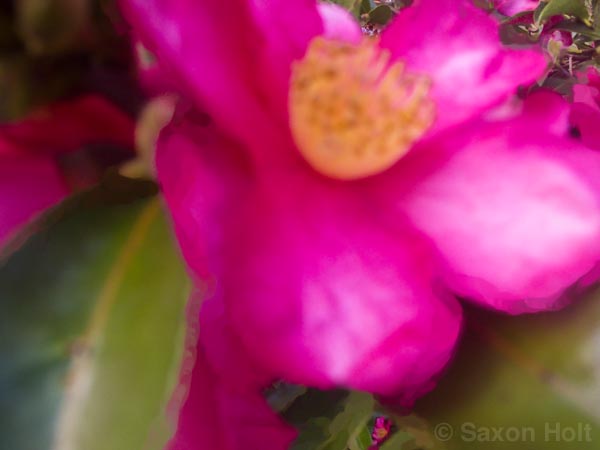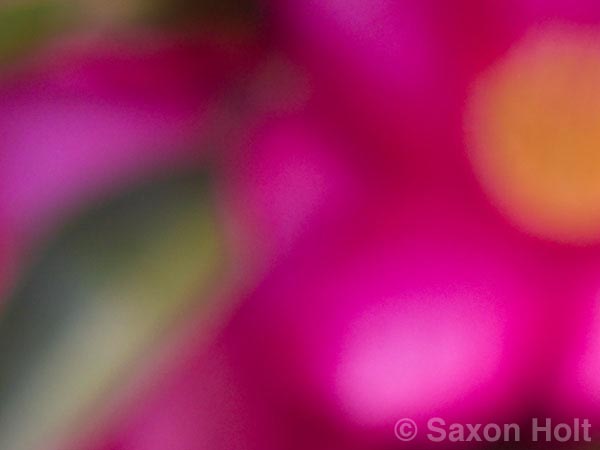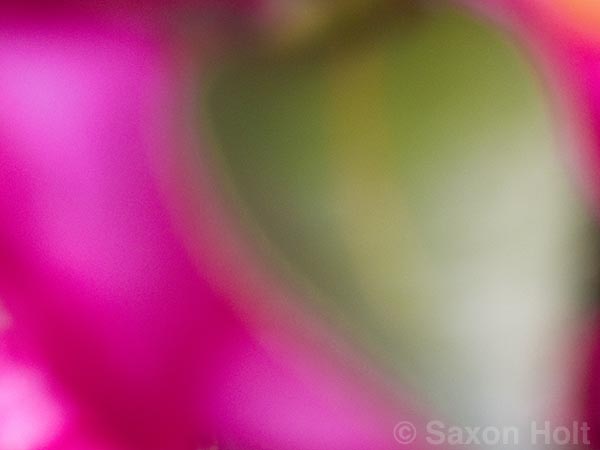After the eye surgery, when I first started exploring what I could see, or not, with my left eye, I went looking for color. The first realization that I could see anything the least bit artistically interesting was when I studied the white flower of Camellia sasanqua ‘Apple Blossom’ after brushing against it in the garden. I wrote about this in M’Eyes. But its white flower only looked gray and foggy through the bubble in my eye. I really wanted to see something bright.
I have several sasanquas in my shrub border and the most intense is ‘Kanjiro’. It was in full bloom and easy to get to, being right along my driveway. So it became my first “study” and I took many different compositions trying to capture something, anything, interesting. I took off my eye glasses and plunged my face into the shrub, rubbing against the flowers. I could not see a thing in my left eye unless it was completely in front of me, and with my right eye still open I could make out some distant details.
Seeing a composition and capturing it with a camera are what I do for a living, but this is different. Now my two eyes see very different things, and one eye barely sees anything. In order to capture something of the duality of what I see I am learning to use the G11 camera and its swivel viewfinder. I can pinpoint the focus in the distance and then hover the camera on top of the flower until I find a composition that is the essence of my blurry vision.
In Kanjiro1, opening this post, I finished off the photo with brush painting in Photoshop on some of the broader color edges. This to convey a bit of the watery, jiggly nature of concentrating with two different eyes at the same time. It is a new thing for me, that I need to finish the photograph with manipulation in post production, but the camera alone can not capture what I see.
Even trying to capture what the one blurry eye sees by itself requires learning a few tricks, made possible with the G11. Typically I shoot with a tripod, composing a scene and filling up the entire frame with carefully chosen elements. But now, my process of understanding what I see is done without the aid of a camera framing a scene. What I see are blurs and vague hints of shape inches from my eye.
With the swivel back of the G11 I can hold the camera away from my face, hover the out-of-focus lens over the flowers, and turn the viewfinder so that my good eye can tell me when to click. After I take each picture, I put my face back into the shrub, now covering my good eye so only the blurs register, then look for and fix upon an impression. Once I have an idea, I pull back, point the camera where my head just was and gingerly frame the blur.
Each time I put my blurry eye to use I get confidence that what it sees is new and worth documenting. These perceptions are truly new. Unlike my nearsightedness, where detail becomes clear when I get close, these blurry impressions are only seen up close. As my brain begins to co-ordinate the camera (and the good eye) to the impressions of my blurry one, I wave the camera outstretched, its lens brushing leaves and flowers, its swivel viewfinder pointing back to me. I feel like I am probing with a remote tool.
My eyes are getting better every day and soon I suspect these blurry camellia photos, already weeks old, will only live in memory never to actually be seen again. I do hope so, but also hope these new perceptions grant me new insight with future work. Onward.












